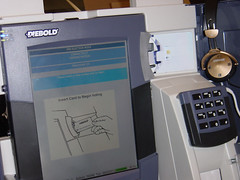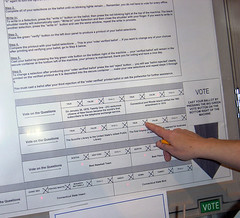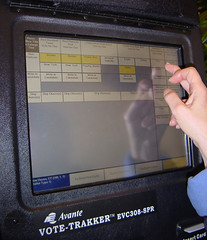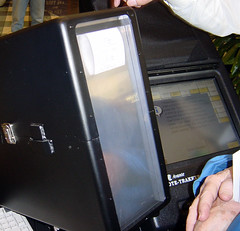All this week, the Secretary of State’s office is offering demonstrations of and soliciting public comment on the three finalists for Connecticut’s electronic voting machines. The line was long at Monday’s demonstration at Buckland Hills Mall in Manchester (easily an hour wait), but well worth it to see what we’re in for when we return to the polls next year.
The following is a breakdown of the three machines being demonstrated and the pros and cons of each.
Machine 1: Diebold AccuVote TS-X
 This voting machine looks like an ATM, which is not surprising given Diebold’s involvement in that market. According to the literature, to use the machine, you take the plastic card—“which looks like a basic ATM or credit card—“given to you by a poll worker, and insert it into the machine. You then use the touch screen to make your choices for each race. When you are nearing completion, you are shown a summary screen which you review and then choose to cast if it looks good. You can touch individual races or “Review Ballot—? to make changes. I have no idea how legible the text on the screen is or how easy to operate this machine is as when I was observing it, they were only showing the “Insert your card—? screen.
This voting machine looks like an ATM, which is not surprising given Diebold’s involvement in that market. According to the literature, to use the machine, you take the plastic card—“which looks like a basic ATM or credit card—“given to you by a poll worker, and insert it into the machine. You then use the touch screen to make your choices for each race. When you are nearing completion, you are shown a summary screen which you review and then choose to cast if it looks good. You can touch individual races or “Review Ballot—? to make changes. I have no idea how legible the text on the screen is or how easy to operate this machine is as when I was observing it, they were only showing the “Insert your card—? screen.
I also did not get to see the voter verified paper trail add-on in action, but it consisted of a little slot with a magnifying plastic door over it in the lower right-hand corner of the machine, where one would assume the paper “receipt—? drops. The plastic flap was open when I was viewing the machine, so I am uncertain as to whether the slip is removed by a person or not.
This machine does offer a set of headphones for someone with disabilities and a numeric keypad which I imagine could be used for making selections, but I was amazed to find that the keypad did not have any braille markings on it to indicate the number. I realize not all blind or visually-impaired people can read braille, but something as basic as the numbers zero through nine can be easily picked up and would greatly improve the usability of this device.
Machine 2: Danaher (Guardian) ELECTronic 1242
 This electronic voting machine is not exactly what I imagine when think electronic voting system. It is electronic, so I suppose it qualifies, but it feels more like playing a game of Battleship or Operation than a casting a vote during an election.
This electronic voting machine is not exactly what I imagine when think electronic voting system. It is electronic, so I suppose it qualifies, but it feels more like playing a game of Battleship or Operation than a casting a vote during an election.
The machine consists of a giant light-up board covered by a large sheet of paper with all of the offices and candidates on it. Each race has a blinking red light associated with it. The voter’s job is to extinguish each red light by pressing on the numbered box corresponding to the candidate they choose. A voter can change his or her mind by clicking the box corresponding to the previously chosen candidate to de-select him or her and then make a new choice. When voting is complete, the voter pushes the large, green “VOTE—? button at the bottom which casts the voter’s virtual ballot.
Personally, I found the “interface—? a little awkward to use as seeing the red lights through the paper was not necessarily easy. I also wonder how easy it would be for someone with macular degeneration or other visual impairment, short of blindness. As for the blind, it appears that they are out of luck with this machine. I couldn’t find a single accessibility feature apart from it being able to be used by someone in a wheelchair (and I question whether the text at the very top of the paper, giving instructions on the machine’s use are actually readable from a height of 3-4 feet). I also failed to see a paper trail on this machine, but perhaps I just missed it.
Machine 3: Avante Vote-Trakker EVC308-SPR
 This was the most promising of the three voting machines exhibited, but it too had its drawbacks. The interface was a touch screen, but the arrangement of the races and questions demonstrated was anything but intuitive (obviously a byproduct of developers “designing—?). One of the better features of this machine was the ability to “zoom in—? on a question or race so that it was essentially all you saw on the screen. The write-in process was a little clunky, requiring the use of a keyboard with no real place to store it for easy access. And who wants to be bothered with juggling a keyboard while trying to vote?
This was the most promising of the three voting machines exhibited, but it too had its drawbacks. The interface was a touch screen, but the arrangement of the races and questions demonstrated was anything but intuitive (obviously a byproduct of developers “designing—?). One of the better features of this machine was the ability to “zoom in—? on a question or race so that it was essentially all you saw on the screen. The write-in process was a little clunky, requiring the use of a keyboard with no real place to store it for easy access. And who wants to be bothered with juggling a keyboard while trying to vote?
 The most interesting feature of this machine was its paper trail. Each vote cast has a unique serial number (which is untraceable to an individual voter, of course), and when you are almost ready to cast your ballot, a paper tally of your votes is displayed in the box next to the machine for you to look at. If it is correct, you cast your votes via the interface. If it is incorrect, you can return to the voting system and change your choices (or alert a poll worker to a discrepancy if what you see on the screen is not what is on the paper) before viewing a new paper “receipt.—? All of the paper receipts are kept in the locked box which displays them in the event of a recount.
The most interesting feature of this machine was its paper trail. Each vote cast has a unique serial number (which is untraceable to an individual voter, of course), and when you are almost ready to cast your ballot, a paper tally of your votes is displayed in the box next to the machine for you to look at. If it is correct, you cast your votes via the interface. If it is incorrect, you can return to the voting system and change your choices (or alert a poll worker to a discrepancy if what you see on the screen is not what is on the paper) before viewing a new paper “receipt.—? All of the paper receipts are kept in the locked box which displays them in the event of a recount.
This machine is pretty accessible to mobility and visually impaired individuals although those with complete blindness would still require some assistance to cast their ballot.
Final thoughts
I am a little disappointed in the range of devices being offered to Connecticut. Perhaps this is a reflection of the poor quality of voting systems available or the poor turnout in the response to the state’s RFP.
My main concern stems from the fact that our current voting machines in Connecticut were originally designed in the late 1800’s (though they were, I imagine, built in the ’40s or ’50s) and we are still using them. Granted, they are mechanical, and changes to a mechanical device are a little more difficult than software upgrades. Still, it is likely that we will have these electronic machines for many decades to come, so we should have the best machines we can.
And this doesn’t even begin to address the potential issues with the underlying software incorrectly recording (or failing to record) votes. I really wish that the companies making the software that powers these machines would have to make their source code available to the public so experts in the field could examine and suggest improvements to the algorithms that will (inevitably) power our democracy.
If you are interested in seeing these machines first-hand and offering your comments to the Secretary of State’s office, please attend one of the remaining exhibitions.
—–




